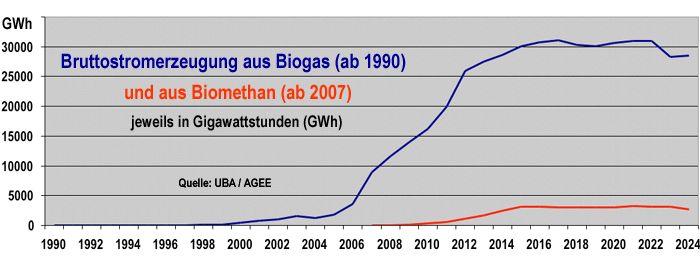 |
|
Biomethane first appears in these statistics in 2007 with 21 GWh. By 2011, this figure will have risen to 596 GWh. This is still simply “biogas,” which is remunerated in accordance with the EEG. The specific term “biomethane” only appears in the EEG applicable from 2012 onwards and receives an extra bonus. This explains why, starting this year, the previous year's volume almost doubled to 1117 GWh. By 2015, this figure rose to 3147 GWh. Another peak was reached in 2021 with 32073 GWh. Since then, electricity generation from biomethane has been declining and will amount to only 2734 MWh in 2024. |
German Environmental Aid warns of methane leaks at biogas plants
On October 8, German Environmental Aid (DUH) presented a study (PDF) showing that up to 370,000 tons of methane escape annually from more than 10,000 German biogas plants. This corresponds to 31.8 million tons of CO2 equivalent per year (climate impact over 20 years) and is more than the annual greenhouse gas emissions of small EU countries such as Cyprus and Malta.
According to the DUH, the study shows that these methane leaks can be significantly reduced through regular inspections, good maintenance, and prompt repairs. These measures are also cost-effective, as every ton of methane that does not escape unused into the atmosphere can be used for energy. Methane is a shorter-lived greenhouse gas than carbon dioxide, as it only remains in the atmosphere for around twelve years. However, it is responsible for around 30 percent of global warming and is 80 times more harmful to the climate than CO2, if the climate impact is estimated at twenty years.
Safety and environmental standards are often not complied with
Although there are sensible safety and environmental standards for biogas production in Germany, these are often not complied with in practice. This is confirmed by a report from the Commission for Plant Safety (KAS), according to which serious deficiencies were found in 69 percent of the biogas plants inspected in 2023: Among other things, the report cites missing or incomplete risk analyses, inadequate documentation, insufficiently trained personnel, and technical deficiencies in shut-off valves or emergency plans. The state authorities are responsible for implementing and monitoring these requirements.
“Significant losses due to methane slip in the exhaust gas of combined heat and power plants”
“Most emissions in biogas plants originate from the combined heat and power plant and the fermentation residue storage facility,” according to the DUH's comments on the report. "Combined heat and power plants cause significant losses due to methane slip in the exhaust gas. These losses can be significantly reduced with modern engines, additional exhaust gas aftertreatment, continuous operation at full load wherever possible, and continuous monitoring. High methane emissions also occur in digestate storage facilities, especially if the storage facilities are open or inadequately covered. These emissions can be significantly reduced through gas-tight covers, shorter storage times, and recovery systems."
Fraunhofer IMM is researching higher methane yields in the conversion of biogas to biomethane
Biogas consists of approximately 50 to 75 percent methane and 25 to 55 percent CO2, as well as smaller proportions of water, nitrogen, hydrogen sulfide, and ammonia. It is mostly used as a special fuel for combined heat and power plants, which generate both electricity and heat. In addition, it is possible to purify biogas from other additives to such an extent that it consists almost entirely of methane and can be used as “biomethane” instead of natural gas or mixed with it.
This process of converting biogas into biomethane releases significant amounts of CO2. This can be considered “climate neutral” insofar as this carbon dioxide was previously removed from the atmosphere by plants. Nevertheless, it would be better if the carbon dioxide could be used to increase the methane yield during conversion. The Fraunhofer Institute for Microengineering and Microsystems IMM is currently working on such a process with its ICOCAD project: It increases the methane yield of biogas plants by utilizing the CO2 produced in the process, converting it into methane using hydrogen and suitable catalysts. The first mini demonstration plant, ICOCAD 1, had a thermal output of ten kilowatts and converted one cubic meter of biogas per hour into one cubic meter of methane. The follow-up project, ICOCAD 2, was five times larger, with a thermal output of 50 kilowatts. An upscaling to 500 kilowatts was planned by 2025. After that, the plant was to generate one to two megawatts of power.
Links (internal)
- Biomass tender oversubscribed for the fifth time (250608)
- Once again, not a single bid in the tender for biomethane (250609)
- Biogas covers half a percent of German gas consumption (140805)
- Biogas feed-in remains far behind the targets set (130811)
- ZSW produces synthetic natural gas with 99 percent methane content (130813)
- Audi produces 6 MW of synthetic natural gas for CNG filling stations (130813)
- Priority for the feed-in of bio natural gas (080306)
- List of links on biomass / biogas
Link (external, no guarantee)
- PDF Quantifying Methan Emissions in European Biogas Systems: A Comparative Supply Chain Analysis (58 p.)